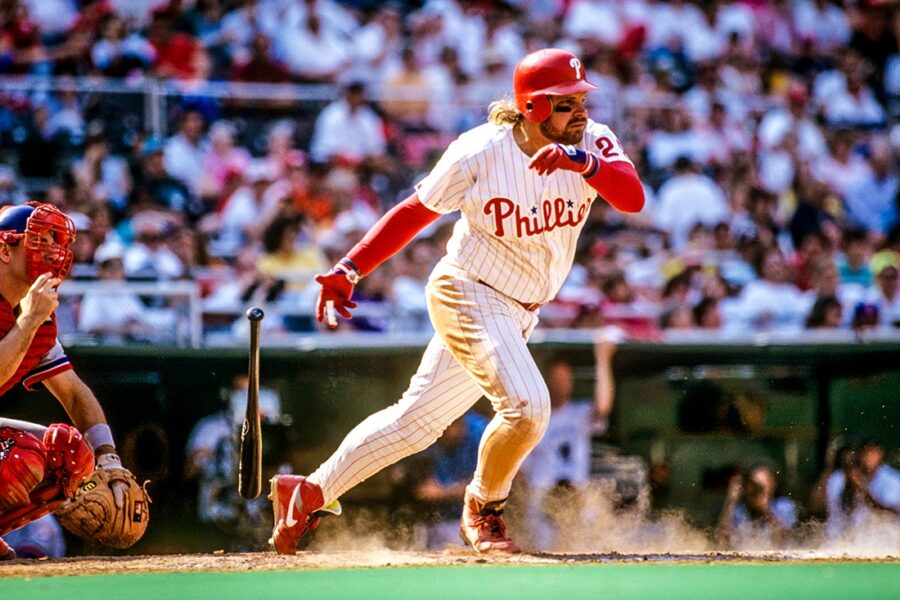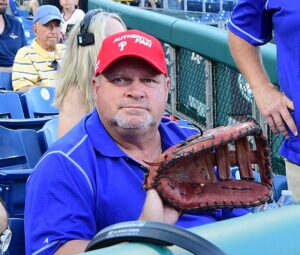
A part of the newest feature of JerseyMan Magazine. Read more by clicking here.
—
As John Kruk’s 10-year Major League Baseball career began to wind down what did he think he would do in the second phase of his life?
“I was hoping I didn’t have to do nothing,” Kruk said. “But that changed. I had to do something. When I retired, I was 33 or maybe 34. So, I had to do something.”
For the past nine years, Kruk has been part of the Phillies television broadcast team sharing time with Ruben Amaro Jr., Ben Davis and Cole Hammels as color analyst, while working alongside play-by-play man Tom McCarthy.
Before that, the former Phillies All-Star and member of the 1993 National League champions worked 13 years for ESPN, first as a studio host and then as an analyst on Sunday Night Baseball.
Being on TV wasn’t at the forefront for Kruk, who began that second phase of life coaching in the Phillies system. Then it all came about one day when he found a note in his locker.
“It wasn’t in the game plan,” Kruk said of broadcasting. “It was spring training, and I was coaching in Reading [Pennsylvania] and somebody left a note in my locker. Normally, I’d never call those people back. For some reason, I called, and it happened to be an agent. He said they were starting this show out in Los Angeles, it was called The Best Damn Sports Show Period. I asked him does that mean they want me? He said, “No, you would have to go out there and audition.” Now, I’m like, “Okay.” But I flew out there for the day and did the audition. By the end of the baseball season, they hired me. So that’s how it all started.”
Kruk was the baseball figure on the show that also included Reggie Theus (basketball), Deacon Jones (football), actor Tom Arnold and the host, Chris Rose in its debut season.
“My wife was pregnant with our son. After he was born, I was trying to go back and forth from Philly to L.A. It was tough. I kept in contact with the Phillies when they were building Citizen’s Bank Park, I was helping them, trying to sell suites and things like that. Then this same agent called and said, ‘What do you think about working at ESPN?’ I didn’t even know they were in Connecticut. My wife and I talked about it and thought it would be a good move to go to work at ESPN.”

Kruk worked in the studio with Karl Ravech doing Baseball Tonight before moving to the booth to do the Sunday night game as the analyst next to play-by-play man Dan Schulman.
“I’d rather do the games,” he said. “I like when you have to think on your feet. I also like it because it’s not scripted. I try to notice things that are going on the field and point them out to the producer to show a replay. You hope to get one of those a game. I don’t think I could do radio where it’s just constant talking. And replays are irrelevant on radio.”
Like several former Philadelphia athletes in all four sports, Kruk came back to the city in 2017 when the Phillies called.
“There’s just something about [Philadelphia],” Kruk said. “It’s hard to explain to someone who’s never played in Philly what it’s like to play in Philly. When we do games now, we talk to the other announcers from the other teams, and they’re amazed at the passion we have here. I mean it’s sold out almost every dang game. It just gets in you. The last thing I ever wanted to do was live in a city-type atmosphere. I’m not a fan of cities, big cities. There’s just something about playing here, and now working here. It doesn’t feel like a big city. It feels like 40,000 people out here cheering and you’re a part of it.”
Those 40,000 are almost 10 times as many people who live in Keyser, West Virginia, a small town across the Potomac River from Maryland, where the population is less than 5,000 and where Kruk was raised.
“It was three older brothers and me and our parents couldn’t wait to get out of the house,” he said.
Sports was Kruk’s way out. Although like becoming a broadcaster, baseball wasn’t number one on his list.
“We played all sports. Baseball wasn’t even close to how much I loved playing basketball,” Kruk said. “After high school, I didn’t get an offer to play baseball. Every Division 2 school in the state of West Virginia recruited me to play basketball. I went to a Junior College to play basketball; if I wanted to play baseball I could try out for the team. I realized right away how talented some of these basketball players were. It was a faster-paced game than I was used to [in high school]. Then the right fielder on the baseball team hurt his knee playing football, so the baseball coach kept asking me to come out for the team. I was a good high school player, but I never played the outfield, I played shortstop. Our high school team wasn’t great. My older brother and I were the two pitchers on the team. When I pitched, he played shortstop. When he pitched, I would play first base. My brother convinced the coach that when he pitched, he wanted me at shortstop. Now they put me in right field, and I was lost. But I guessed it worked out all right.”
It sure did. Kruk was drafted out of Allegany Community College (Maryland) in the third round (62nd overall) of the 1981 draft by the San Diego Padres. He played three full years for the Padres being before traded to the Phillies during the 1989 season for outfielder Chris James.
In his five-plus seasons with the Phils, he went to three All-Star games. And in his 10 seasons, the final one with the Chicago White Sox, he hit over .300 eight times. His lowest batting average for a season was .291 in 1990, his first full season in Philadelphia.
The game that Kruk played in the late ‘80s and early ‘90s is not the same one he broadcasts today. In 2024 a total of seven players batted over .300, including Atlanta’s Marcell Ozuna who checked in at .302. Pitchers threw 26 complete games over the 162-game season, a record low. Yeah, the game has changed.
“When I played the other team decided how long the pitcher lasted,” Kruk said.
“I think if you ask the players, especially starting pitchers, they would say they want to go deeper. I heard [Pittsburgh star pitcher] Paul Skene say, ‘I trained my body to not just throw 100 pitches a game, but to throw however many I need.’ His goal every game is to go nine innings. But it’s just not the way things are done anymore.”
So, what happened?
“Velocity is up across the board,” Kruk said. “With velocity, the art of pitching is down. Guys come in and throw. They don’t pitch. They just throw. There’s no location now. Sixty to seventy-five percent of pitchers just throw. The guys who can pitch are successful. Everyone asks me about hitters now with the elbow guards, face mask, shin guard. I never wore any of that stuff. But when I see some of these guys pitch, I don’t blame them.”
And what about the hitters? Why is .235 an OK batting average these days?
“Pitchers aren’t afraid to walk guys anymore,” Kruk said. “I’ve seen pitchers throw sliders on a 3-0 count. I think that’s why batting averages are down. Pitchers would rather walk you than give you a cookie to hit.”
And don’t get Kruk started on the A-word.
“Here’s the thing with me and analytics,” he said. “When analytics came in it was OPS and whatever, whatever. They discounted batting average. I got into it once with an analytics guy. I asked him, ‘Why do you discount batting average?’ He said, ‘It’s not important.’ I said, ‘Well, isn’t it part of the on-base percentage?’ It kind of stumped him. Which was nice.
“Now to validate when people discounted OPS, they [then] came up with OPS plus and WAR plus and this plus and that plus. They keep changing the narrative. If analytics worked 15, 20 years ago, then why do they keep changing it?”
Kruk does see some change this season. It’s not all the way there, but maybe it’s getting there.
“Teams are starting to go back,” Kruk said. “Well, they’re always going to use analytics, but I think teams are going, ‘Ok here’s the analytical information but go out and play your way.’ And I think that’s smart, trust your players. The Phillies this year have done a better job of putting balls in play and surprisingly they’re scoring more runs. It just makes sense doesn’t it.”
What about the pitch clock, bigger bases and putting a man on second in extra innings?
“As an announcer, I like [the pitch clock],” Kruk said. “I’m not sure as a player. There were some pitchers who were slow or who threw over [to first] 20 times. And some hitters, I don’t want to call them rituals, but you know. So. . .
“I don’t like bigger bases. Guys need to learn how to slide. Sliding gloves, some of these guys have an extra 2-3 inches when they slide with that oven mitt on. I don’t like that.”
And the extra inning rule?
“We played some long games,” Kruk recalled. “I remember a 20-inning game. I know why they did it, to protect pitchers. And baseball is doing everything it can to protect pitchers, and I get it. But there was something about playing those long games. Mike Williams pitched eight innings of that 20-inning game. That will never happen again. As an announcer, I like it because there’s always stress. You start with a runner on second. But overall, I’m not sure.”
Kruk is sure about one thing. He loves doing what he does. Instead of driving in Lenny Dykstra, or setting up Darren Daulton and Dave Hollins, he’s sitting next to McCarthy and explaining what’s going on to most of those same Phillies fans who cheered for him back in the day.
“I love Tom,” Kruk said. “I love working with him. I’ve been so lucky through this second phase of my life. Carl was great to work with. Then Sunday night, Dan was unbelievable. Now working with Tom is great. I couldn’t have asked for anything more from those three.”

